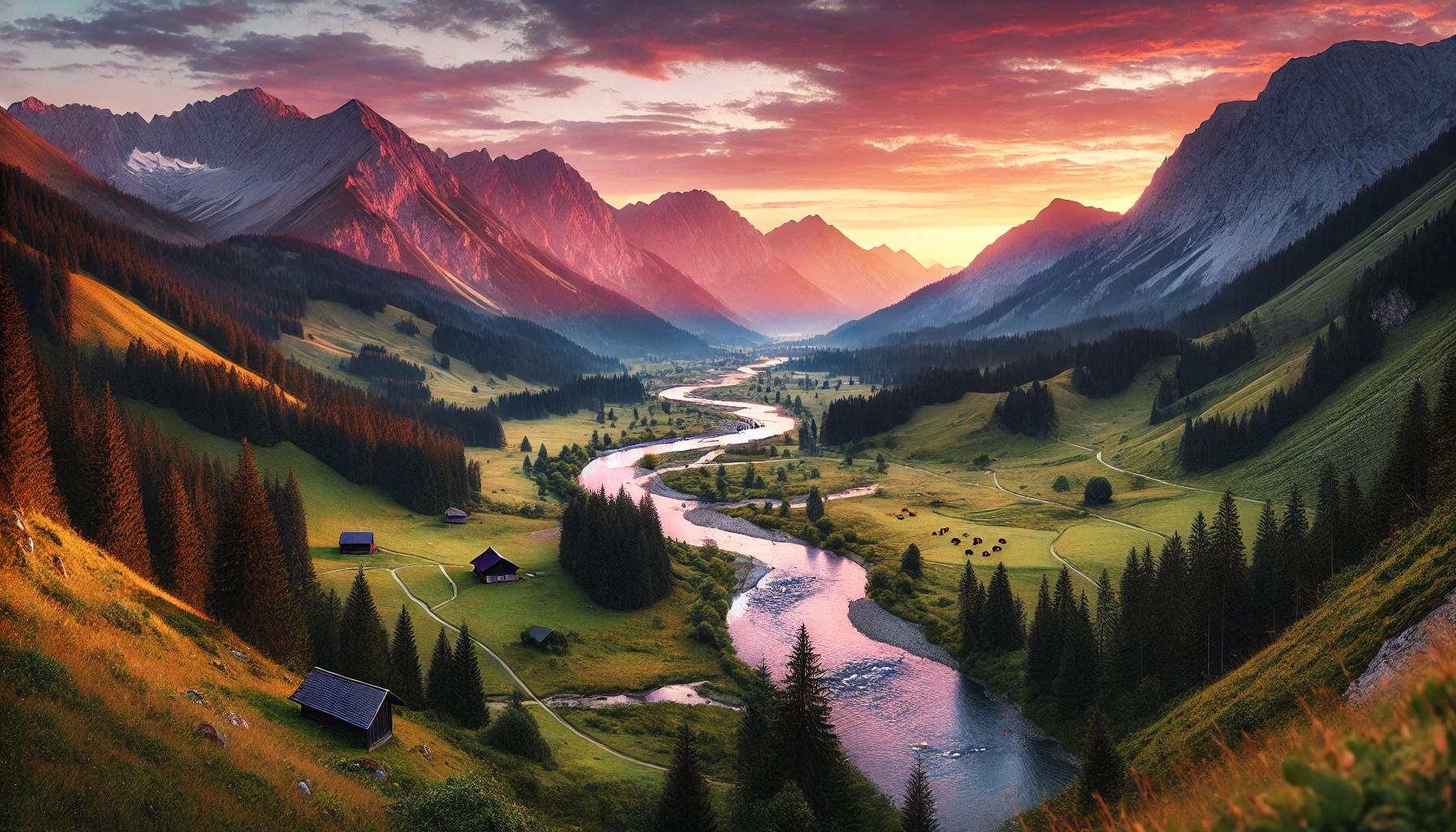
Mountain valleys are among the most stunning landscapes on Earth, offering a blend of natural beauty and geological intrigue. These valleys, carved by powerful forces of nature, tell a story of Earth’s dynamic history. From the rugged, steep V-shaped valleys to the broad, sweeping U-shaped ones, each type has its unique charm and significance. The intricate interplay of ecological elements within these valleys creates diverse habitats that are vital for numerous plant and animal species. Join us as we explore the fascinating world of mountain valleys, uncovering their formation, ecological importance, and cultural relevance.
Definition and Types of Mountain Valleys
Definition of Mountain Valleys
Mountain valleys are elongated depressions nestled between mountain ranges, typically formed through geological processes such as erosion by rivers and glaciers. These valleys are defined by their steep sides and flat or gently sloping floors, making them distinct from other types of valleys. The formation of mountain valleys often involves a combination of tectonic activity, weathering, and the persistent force of flowing water or glacial movement.
Types of Mountain Valleys
Mountain valleys come in various shapes and sizes, primarily categorized into two main types: V-shaped valleys and U-shaped valleys. Each type has unique characteristics shaped by different natural forces.
V-Shaped Valleys
V-shaped valleys are characterized by their narrow, steep-walled profiles that resemble the letter “V.” These valleys are typically formed by the erosive action of rivers over long periods. As rivers cut through rock and soil, they carve out these distinct shapes, with the valley floor remaining relatively narrow compared to its height. V-shaped valleys are often found in regions with significant rainfall, where rivers have enough power to erode the landscape efficiently. The sides of V-shaped valleys are usually covered with vegetation, contributing to their striking appearance.
U-Shaped Valleys
U-shaped valleys, in contrast, have a broader, more rounded profile that resembles the letter “U.” These valleys are primarily formed by the movement of glaciers, which exert immense pressure on the land as they advance and retreat. The process of glacial erosion smooths and widens the valley floor, creating a characteristic U-shape. U-shaped valleys are often found in regions that experienced significant glaciation during the last Ice Age. The sides of these valleys can be quite steep and rugged, with glacial striations and moraines frequently visible.
Both V-shaped and U-shaped valleys offer unique insights into the geological history of an area. While rivers and glaciers are the primary forces behind their formation, other factors such as rock type, climate, and tectonic activity also play a role. Exploring the differences between these valley types helps us understand the dynamic processes that shape our planet’s surface.
Formation and Geomorphology
Geological Formation and Development
Mountain valleys are shaped by a complex interplay of geological processes. The primary forces at work include tectonic activity, erosion by rivers, and the movement of glaciers. Tectonic forces, driven by the movement of the Earth’s plates, create the initial uplift of mountains, providing the necessary height and slope for valley formation. Over time, rivers and glaciers carve through these uplifted terrains, sculpting the valleys into their characteristic shapes.

Erosion by rivers is a gradual process where the flowing water cuts through rock and soil, deepening and widening the valley over millennia. This erosion is most effective in areas with significant precipitation, where rivers have the power to transport large amounts of sediment. The continuous flow of water not only deepens the valley but also shapes the sides, creating the steep, V-shaped profiles commonly associated with river valleys.
In contrast, glacial activity results in U-shaped valleys. During periods of glaciation, glaciers advance and retreat, grinding against the valley floor and walls with immense force. This glacial erosion smooths the valley floor and steepens the sides, resulting in the broad, rounded profiles typical of U-shaped valleys. The debris left behind by glaciers, known as moraines, further shapes these valleys, adding to their unique geological features.
Factors Influencing Their Formation
Several factors influence the formation of mountain valleys, including rock type, climate, and tectonic activity. The type of rock present in an area determines how easily it can be eroded by rivers and glaciers. Softer rocks, such as shale and limestone, are more susceptible to erosion, leading to faster valley formation. Harder rocks, like granite, resist erosion, resulting in slower development and often more rugged valley landscapes.
Climate plays a significant role in valley formation. Regions with high precipitation levels support vigorous river erosion, while areas that experienced extensive glaciation during the last Ice Age have well-defined U-shaped valleys. Temperature fluctuations also affect the rate of erosion, with freeze-thaw cycles contributing to the breakdown of rock in colder climates.
Tectonic activity not only creates the initial uplift needed for valley formation but also influences the ongoing development of valleys. Earthquakes and volcanic activity can alter the landscape, creating new pathways for rivers and changing the course of glacial movement. These dynamic processes continuously reshape mountain valleys, contributing to their diverse and evolving nature.
Unique Geological Features
Mountain valleys often exhibit unique geological features that provide insights into their formation and history. In V-shaped valleys, features such as waterfalls and rapids are common, formed by the uneven erosion of rock layers. Terraces, or step-like landforms, can also be found along the valley sides, indicating past levels of river flow and sediment deposition.
U-shaped valleys, on the other hand, often contain evidence of glacial activity, such as striations (grooves) on the valley floor and sides, caused by the movement of glaciers. Hanging valleys, which are smaller valleys perched above the main valley floor, are also a distinctive feature of glacial valleys. These occur when tributary glaciers erode the landscape less deeply than the main glacier, leaving the tributary valley “hanging” above the main valley.
Moraines, composed of rock and sediment deposited by glaciers, are another common feature in U-shaped valleys. These accumulations of debris can form ridges along the valley floor or sides, marking the past extent of glacial movement. Glacial lakes, created by the damming of water by moraines or the melting of ice, are often found in these valleys, adding to their scenic beauty and geological interest.
Mountain valleys, with their diverse forms and features, offer a window into the powerful forces that shape our planet. The study of these valleys not only enhances our understanding of geological processes but also highlights the intricate interplay between the Earth’s natural elements.
Ecological and Environmental Aspects
Flora and Fauna of Mountain Valleys
Mountain valleys host a diverse array of plant and animal life, each adapted to the unique conditions of their environment. The flora of mountain valleys often includes a variety of grasses, shrubs, and trees that can withstand the temperature fluctuations and varied soil types found in these regions. Lower elevations might feature dense forests, while higher elevations are characterized by alpine meadows and hardy, low-growing plants.
In terms of fauna, these valleys provide habitats for numerous species. Mammals such as deer, mountain goats, and bears are commonly found, taking advantage of the abundant plant life and sheltered conditions. Birds, ranging from small songbirds to large raptors, also thrive in mountain valleys, benefiting from the varied landscape and plentiful food sources. Insects and smaller creatures, such as rodents and amphibians, complete the intricate web of life in these ecosystems.
Environmental Challenges and Climate Impact
Mountain valleys face significant environmental challenges, many of which are exacerbated by climate change. One of the primary issues is the alteration of water sources. Glacial retreat, a direct result of rising global temperatures, impacts the flow of rivers that carve and sustain these valleys. This reduction in water flow can lead to the drying up of rivers, affecting the entire ecosystem dependent on consistent water availability.
Another challenge is the increased occurrence of extreme weather events. Floods, landslides, and avalanches become more common as climate patterns shift, posing risks to both the natural environment and human settlements within these valleys. The loss of vegetation due to such events can lead to soil erosion, further destabilizing the landscape.
Biodiversity Conservation Efforts
Efforts to conserve the biodiversity of mountain valleys are multifaceted and critical for maintaining ecological balance. Protecting these areas involves creating and enforcing regulations that limit deforestation, overgrazing, and unplanned development. Establishing protected areas, such as national parks and nature reserves, helps preserve large tracts of land where ecosystems can function relatively undisturbed.
Reforestation and habitat restoration projects are vital components of conservation strategies. By replanting native vegetation and restoring natural habitats, these efforts aim to rebuild the ecological networks that support diverse species. Additionally, conservation programs often focus on the protection of specific endangered species, implementing measures to boost their populations and ensure their survival.
Climate change mitigation is another crucial aspect of conserving mountain valleys. Reducing carbon emissions on a global scale helps slow the rate of glacial melt and extreme weather events, indirectly benefiting these ecosystems. Local initiatives, such as promoting sustainable agriculture and forestry practices, also play a significant role in maintaining the health of mountain valleys.
The Role of Mountain Valleys in Climate Regulation
Mountain valleys contribute significantly to regional and global climate regulation. The vegetation in these areas acts as a carbon sink, absorbing carbon dioxide from the atmosphere and helping mitigate the effects of climate change. Forested valleys, in particular, play a crucial role in sequestering carbon and maintaining air quality.
The water systems within mountain valleys, including rivers and glacial runoff, are vital for regulating water cycles. These systems support agriculture, drinking water supplies, and hydropower generation for millions of people. The natural filtration process provided by these water systems ensures the availability of clean water downstream.
Mountain valleys also influence local weather patterns. The topography and vegetation can affect wind flow, precipitation, and temperature distribution in surrounding areas. This microclimatic effect is essential for maintaining the balance of local ecosystems and agricultural productivity.
Understanding and protecting the ecological and environmental aspects of mountain valleys is essential for preserving their beauty and functionality. These efforts not only benefit the immediate surroundings but also contribute to broader environmental stability and biodiversity.
Historical and Cultural Significance
Historical Significance and Notable Events
Mountain valleys have been pivotal in human history, serving as natural routes for migration, trade, and conquest. Many ancient civilizations settled in or around these valleys, drawn by the fertile land and abundant water resources. Over centuries, these valleys have witnessed significant historical events, such as battles, treaties, and the rise and fall of empires.
For instance, the Indus Valley, nestled in the mountains of South Asia, was the cradle of the ancient Indus Valley Civilization. This early civilization made remarkable advances in urban planning, agriculture, and trade, leaving a lasting legacy on the region’s culture and history. Similarly, the valleys of the Andes have been home to the Inca Empire, known for its sophisticated agricultural terraces and monumental architecture.
Cultural Symbolism and Representation in Literature
Mountain valleys have long been a source of inspiration in literature and art, symbolizing peace, seclusion, and natural beauty. In various cultures, these valleys are often depicted as idyllic settings, offering refuge from the chaos of everyday life. Poets and writers have used the serene landscapes of mountain valleys to convey themes of tranquility, introspection, and spiritual awakening.

In Western literature, valleys such as the English Lake District have been immortalized by poets like William Wordsworth, who found inspiration in their scenic beauty. Wordsworth’s poetry celebrates the harmonious relationship between humans and nature, often set against the backdrop of lush valleys and rolling hills.
In Eastern traditions, mountain valleys also hold significant cultural and spiritual value. In Chinese and Japanese art, these landscapes are frequently depicted in paintings and poetry, symbolizing harmony with nature and the pursuit of enlightenment. The depiction of valleys in these cultures often emphasizes their tranquil and meditative qualities, inviting viewers to reflect on the natural world and their place within it.
Impact on Local Traditions and Folklore
The unique environments of mountain valleys have given rise to rich traditions and folklore among the communities that inhabit them. These stories and customs are deeply intertwined with the natural features of the valleys, reflecting the close relationship between the people and their surroundings.
In many mountain regions, folklore includes tales of mythical creatures and spirits that inhabit the valleys. These stories often serve to explain natural phenomena and instill a sense of respect and reverence for the land. For example, in the Himalayas, the Yeti is a legendary creature said to roam the high valleys and mountains, embodying the mystery and majesty of the region.
Traditional festivals and rituals in mountain valleys often celebrate the changing seasons and agricultural cycles. These events are crucial for maintaining community bonds and preserving cultural heritage. In the Swiss Alps, the annual Almabtrieb festival marks the descent of cattle from the high mountain pastures to the valleys below, a practice that has been carried out for centuries and remains a vibrant part of local culture.
Influence on Modern Culture
The allure of mountain valleys extends into modern culture, influencing art, literature, and even popular media. Contemporary writers and filmmakers frequently draw on the dramatic landscapes of mountain valleys to create compelling settings and narratives. These natural backdrops provide a sense of adventure, mystery, and beauty that resonates with audiences worldwide.
Mountain valleys have also become symbols of environmental conservation in modern discourse. Their pristine environments highlight the importance of protecting natural landscapes from the impacts of climate change and human activity. Documentaries and advocacy campaigns often feature the striking imagery of these valleys to raise awareness about environmental issues and inspire action.
The historical and cultural significance of mountain valleys is profound, reflecting their role as both physical and symbolic landscapes. From ancient civilizations to modern environmental movements, these valleys continue to shape human experiences and cultural expressions, underscoring their enduring importance in our world.
Tourism and Recreation
Popular Activities
Mountain valleys offer a variety of recreational activities that attract tourists from around the world. These activities capitalize on the natural beauty and unique topography of the valleys, providing opportunities for adventure and relaxation.
- Hiking and Trekking: Mountain valleys are prime destinations for hiking and trekking enthusiasts. Trails of varying difficulty levels wind through these valleys, offering hikers stunning views of the landscape, diverse flora and fauna, and a sense of accomplishment upon reaching their destinations. Famous hiking spots like the Appalachian Trail in the United States and the Inca Trail in Peru attract thousands of visitors each year.
- Camping and Backpacking: The serene environment of mountain valleys makes them ideal for camping and backpacking. Campers can enjoy the tranquility of nature, starry night skies, and the sounds of wildlife. Many valleys have designated camping areas with basic amenities, while more remote locations offer a true wilderness experience.
- Water Activities: Rivers and lakes within mountain valleys provide opportunities for various water-based activities. Kayaking, canoeing, and fishing are popular pursuits that allow visitors to engage with the natural water bodies. In regions with suitable conditions, white-water rafting offers an adrenaline-pumping experience.
- Winter Sports: During the winter months, many mountain valleys transform into hubs for winter sports. Skiing, snowboarding, and snowshoeing are common activities in areas with sufficient snowfall. Valleys in the Alps, Rockies, and Andes are renowned for their ski resorts and winter tourism infrastructure.
- Wildlife Watching: Mountain valleys are home to diverse wildlife, making them excellent locations for wildlife watching. Visitors can observe animals in their natural habitats, often encountering species that are rare or unique to the region. Guided tours and observation platforms enhance the experience by providing insights into the local ecology.
Tourist Attractions and Travel Tips
Mountain valleys host numerous tourist attractions that highlight their natural and cultural heritage. These attractions often include scenic viewpoints, historical sites, and cultural landmarks.
- Scenic Viewpoints: Many valleys feature lookout points that offer panoramic views of the surrounding landscape. These viewpoints are often accessible by short hikes or drives and provide excellent opportunities for photography and sightseeing. Famous viewpoints include Glacier Point in Yosemite Valley and the viewpoint at Lauterbrunnen Valley in Switzerland.
- Historical Sites: The rich history of mountain valleys is reflected in numerous historical sites scattered throughout these regions. Ancient ruins, old settlements, and cultural monuments provide glimpses into the past and the people who once inhabited these areas. Machu Picchu in Peru and the castles in the Rhine Valley are prime examples of such sites.
- Cultural Landmarks: In addition to historical sites, mountain valleys often feature cultural landmarks such as temples, churches, and traditional villages. These landmarks highlight the cultural diversity and heritage of the valley’s inhabitants. The monasteries in Bhutan’s valleys and the traditional chalets in Swiss valleys attract culturally inclined tourists.
Travel Tips
Visiting mountain valleys requires some preparation to make the experience enjoyable and safe. Here are a few tips to consider:
- Planning Your Trip: Research the best times to visit, local regulations, and necessary permits. Some valleys are best visited during specific seasons to avoid harsh weather conditions.
- Sustainable Travel Practices: Respect the natural environment by following Leave No Trace principles. This includes packing out all trash, minimizing campfire impacts, and staying on designated trails to prevent erosion and damage to vegetation.
- Packing Essentials: Bring appropriate gear for the activities you plan to engage in. This might include hiking boots, camping equipment, and weather-appropriate clothing. Don’t forget essentials like a first aid kit, water purification methods, and maps or GPS devices.
- Acclimatization: If traveling to high-altitude valleys, allow time for acclimatization to prevent altitude sickness. Ascend gradually, stay hydrated, and avoid overexertion during the initial days.
Mountain valleys offer a blend of adventure, natural beauty, and cultural experiences, making them appealing destinations for a wide range of tourists. Whether you’re seeking thrilling outdoor activities or peaceful retreats in nature, these valleys provide an ideal backdrop for memorable journeys.
Climate and Weather Patterns
Typical Weather Patterns in Mountain Valleys
Mountain valleys exhibit diverse weather patterns influenced by their elevation, latitude, and topography. The climate in these valleys can range from temperate to alpine, depending on their geographic location and altitude. Common characteristics of mountain valley weather include significant temperature variations, distinct seasons, and localized weather phenomena.

- Temperature Variations: Temperature in mountain valleys can vary greatly between day and night. Higher elevations tend to have cooler temperatures, even during summer months. This diurnal temperature variation can result in warm days followed by chilly nights, requiring visitors to be prepared for a range of conditions.
- Seasonal Changes: Mountain valleys typically experience well-defined seasons. Winters can bring heavy snowfall and cold temperatures, transforming the landscape into a winter wonderland ideal for snow sports. Spring and summer see a thaw, with blooming wildflowers and increased water flow in rivers and streams. Autumn often brings a spectacular display of fall foliage, attracting tourists to witness the vibrant colors.
- Precipitation Patterns: Precipitation in mountain valleys can be quite variable. Some valleys receive abundant rainfall or snowfall, while others may be located in the rain shadow of surrounding mountains, resulting in drier conditions. Summer months often bring thunderstorms, which can cause sudden weather changes and heavy downpours.
- Localized Weather Phenomena: The topography of mountain valleys can lead to unique weather phenomena such as valley fog, where cool air settles in the valley floor, leading to foggy conditions. Temperature inversions are also common, where cold air is trapped in the valley while warmer air layers above it. These inversions can lead to prolonged periods of cold weather and air pollution issues in some valleys.
Impact of Climate on Valley Ecosystems
The climate of mountain valleys plays a crucial role in shaping their ecosystems. The interplay of temperature, precipitation, and seasonality determines the types of plants and animals that can thrive in these environments.
- Flora: Plant life in mountain valleys is highly adapted to the local climate. In lower, more temperate valleys, forests of deciduous and coniferous trees are common. Higher elevations and alpine valleys support hardy grasses, shrubs, and specialized alpine plants that can withstand harsher conditions. Seasonal variations influence the growth cycles of these plants, with spring and summer being periods of rapid growth and flowering.
- Fauna: Animal species in mountain valleys have evolved to cope with the climatic conditions. Mammals such as deer, bears, and smaller rodents are well-adapted to the temperature fluctuations and seasonal changes. Birds migrate to these valleys during certain times of the year, taking advantage of the abundant food resources. Cold-blooded animals like reptiles and amphibians are less common at higher elevations but can be found in lower valleys with milder climates.
- Water Resources: The climate significantly affects water resources in mountain valleys. Snowmelt from winter precipitation provides a vital source of water during spring and summer, feeding rivers and streams that support both human and ecological needs. Changes in climate, such as reduced snowfall or altered precipitation patterns, can impact these water resources, affecting everything from agriculture to wildlife habitats.
Influence of Climate Change
Climate change poses significant challenges for the ecosystems of mountain valleys. Shifts in temperature and precipitation patterns can disrupt the delicate balance of these environments.
- Glacial Retreat: Many mountain valleys are fed by glaciers, which are retreating due to rising global temperatures. This retreat reduces the availability of meltwater, impacting river flows and the ecosystems that depend on them. Glacial retreat also contributes to rising sea levels, with broader implications for global climate systems.
- Biodiversity Loss: Changing climate conditions can lead to shifts in the distribution of plant and animal species. Some species may migrate to higher elevations to find suitable habitats, while others may face extinction if they cannot adapt quickly enough. This biodiversity loss affects the entire ecosystem, altering food webs and ecological interactions.
- Increased Frequency of Extreme Weather: Climate change is linked to an increase in the frequency and intensity of extreme weather events such as storms, floods, and droughts. These events can have devastating effects on mountain valley ecosystems, leading to soil erosion, habitat destruction, and increased vulnerability of species.
- Human Impact: The livelihoods of people living in mountain valleys are also affected by climate change. Agricultural practices, water availability, and tourism can all be impacted by changing weather patterns. Adapting to these changes requires significant effort and innovation to sustain the ecological and economic health of these regions.
Understanding the climate and weather patterns of mountain valleys is essential for appreciating their ecosystems and the challenges they face. As climate change continues to affect these regions, it becomes increasingly important to monitor and mitigate its impacts to preserve the natural beauty and biodiversity of mountain valleys for future generations.
Conclusion
Mountain valleys, with their breathtaking landscapes and diverse ecosystems, hold significant geographical, ecological, and cultural importance. These natural formations, shaped by various geological processes, provide habitats for unique flora and fauna while supporting human communities through resources and recreational opportunities. The historical and cultural significance of these valleys adds to their allure, making them treasured destinations for exploration and study. As climate change continues to impact these delicate environments, understanding and protecting mountain valleys becomes increasingly important. Preserving these natural wonders ensures that future generations can experience their beauty and benefit from their ecological and cultural richness.
FAQs
1. What are the main types of mountain valleys?
Mountain valleys are primarily classified into V-shaped and U-shaped valleys. V-shaped valleys are formed by river erosion, while U-shaped valleys are created by glacial activity.
2. How do mountain valleys influence local climates?
Mountain valleys can affect local climates through temperature variations, precipitation patterns, and unique weather phenomena such as valley fog and temperature inversions.
3. What kinds of recreational activities can be enjoyed in mountain valleys?
Popular activities include hiking, camping, water sports like kayaking and fishing, and winter sports such as skiing and snowboarding. Wildlife watching and exploring historical sites are also common.
4. Why are mountain valleys important for biodiversity?
Mountain valleys support diverse ecosystems, providing habitats for a wide range of plant and animal species. Their varied climates and elevations create unique environments that are crucial for maintaining biodiversity.
5. How is climate change impacting mountain valleys?
Climate change is leading to glacial retreat, altered precipitation patterns, and more frequent extreme weather events. These changes affect water resources, biodiversity, and the livelihoods of people living in these areas.







